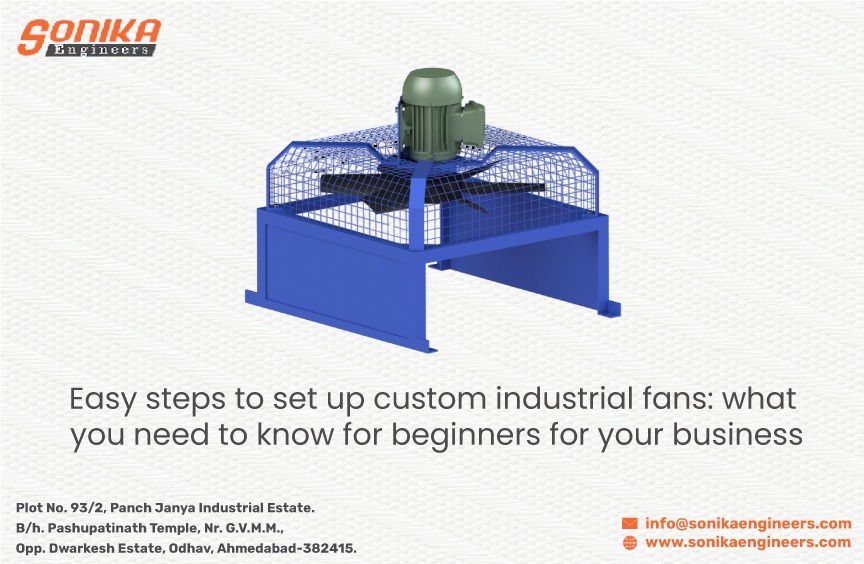Installing a custom industrial fan for your business does not need to be challenging. Regardless of if you're running a factory, workshop, or warehouse, proper air movement is key to managing temperature, air quality, and productivity. In this article, we will walk you through the easy steps to set up and install your fan system, as well as why the right industrial air blower can help your operation.
What Are Custom Industrial Fans
Custom industrial fans are designed to fit your facility's precise airflow, pressure, and environmental requirements. While standard fans are, built to run in a standard environment. Custom fans are engineered to work under specific conditions such as high temperature, dust, fumes, or high humidity - this makes them effective and durable.
Key Benefits:
- Maximized airflow: optimized fan effectively circulates air and allows for the safest working environment possible.
- Energy efficient: a custom fan can allow you to spend less on your electric bill than a standard fan.
- Extended life: custom components will last longer in a more rigorous industrial setting.
Step 1: Determine Your Ventilation Requirements
Prior to installation, evaluate the needs of your work space. Keep in mind the following items:
- Size of the area — larger spaces may require multiple fans or a fan with larger CFM.
- Type of process — Determine if there is heat, smoke or dust produced in the environment.
- Airflow Direction – Determine if you need exhaust, supply, or a combination sugar of air flow.
The assessment shows that your fan system will be sized correctly and positioned to maximize performance.
Step 2: Selecting the Appropriate Type of Fan
There are various kinds of industrial fans that can be grouped into axial, centrifugal, and mixed-flow fans. These types serve specific purposes.
- Axial fans are of most benefit in general purpose ventilation applications for larger spaces.
- When high pressure is needed, centrifugal fans are ideal, as in dust collection systems to material handling systems.
- Mixed flow fans achieve the best of both worlds in fan systems by delivering both efficiencies and quiet operation.
Ask an expert, such as Sonika Engineers, to assist with selecting the right type of fan for your specific business application.
Step 3: Getting the Installation Site Ready
Proper preparation of the site is important for safety and efficient installation.
- Clear the site you will be sending the fan into.
- Make sure it is a secure mounting structure that can hold the weight of the fan.
- Electrically, you will want to make sure the existing wiring is done safely and to code.
Also, proper alignment before installation reduces vibration and mechanical issues later on.
Step 4: Install the Fan and Electrics
Make sure you strictly follow all manufacturer guidance.
- Secure the fan in place with bolts and anti-vibration pads.
- Connect the power supply as specified for the relevant voltage.
- Double-check that all wires are safely grounded.
After installation, a dry test run will allow you to quickly detect noise, imbalance, or airflow issues.
Why Selecting the Correct Industrial Air Blower is Important
Choosing the right industrial air blower provides more than just increased airflow. It decreases ambient air temperature, improves air quality, improves thermal conditions of machinery, and maintains airflow conditions in the environment — all of which contribute to higher productivity and better worker comfort. An efficient air blower will also help you to save on your energy bill - a wise investment for the long term.
Frequently Asked Questions
Q1. Can one fan be used across multiple areas?
This depends on the layout of the space. If the space is large or has separations, it might be best to use multiple units to ensure even airflow is achieved.
Q2. How often should industrial fans be inspected/serviced?
Fans should be checked regularly every 3–6 months to ensure that the unit is working properly and to help prevent any downtime in operation.
Conclusion
Designing custom industrial fans can be simple — with the right process of planning, specifying, and installation, you will not only improve air circulation, you will also improve the efficient use of energy and a reliable air circulation will keep your work environment safe, comfortable, and productive.
If you need to design or install a fan system for your industrial requirements, contact Sonika Engineers to provide you with specific solutions to your applications with expertise and guided knowledge in engineered products.
